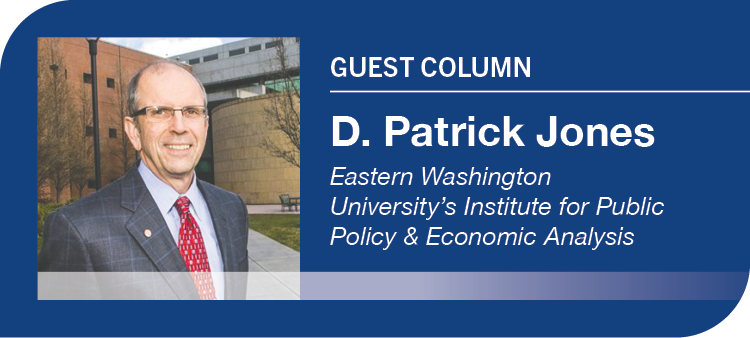
Home » Participation in local labor force has declined but has now stabilized
Participation in local labor force has declined but has now stabilized

November 11, 2022
What’s at stake over a once obscure economic measure – the labor force participation rate? The quick answer: A lot for the current and future economy of the greater Tri-Cities.
Machines and robots are replacing labor in some occupations. But growth of an economy still largely depends on the growth of the labor force. And the growth of the labor force depends on two factors: general population increases of the working-age population, and the willingness of this population to engage in work.
The labor force participation rate measures the second factor. It is defined as the number of people employed plus the number unemployed but actively seeking work, divided by the total population of a defined age group.
The ratio is captured in this Benton-Franklin Trends graph. As of 2021 the rate, measured for the population ages 16 and above, was about 63%. The Washington average was about 62%. The U.S. rate, not shown in the graph, was 62%. Economists and economic development specialists think the higher, the better.
By this comparison, the two counties are outperforming. But next to other Eastern Washington metro areas, not so much.
The greater Wenatchee area had a rate of about 68% in 2021, followed by the counties of Yakima, at about 67%, and Walla Walla, at 66%. Coming in lower was Spokane County, at 60%, and Grant County at 58%.
Not every part of a community participates in the workforce equally.
Obviously, age matters. No local figures are available, but national ones are.
To no surprise, the group that engages in work the most is composed of prime working ages, 25-54. According to the Bureau of Labor Statistics (BLS), nearly 82% of this group engaged in the labor force in 2021 nationwide.
To no surprise, the segment of the national population least engaged is the 55+ group, at about 38% in 2021. Youth participation in 2021, nationwide, was estimated to be in the middle, at 56%
Not surprisingly, averages of these three age groups mask considerable variation.
For example, in the 55+ group, the participation rate for the sub-group 55-64, at approximately 65%, was much higher than the group 65-74, at 26%. And the teenage participation rate, measured for the 16-19 age group, was 36%, about half of the rate of young adults, 20-24, which stood at 71% nationally.
Consequently, a community that has a relatively high proportion of its population in the teenage years will show, all other factors equal, a lower participation rate.
Young people are definitely present in the greater Tri-Cities, as Trends data shows. For the 0-17 age group, the share here is more than five percentage points higher than the Washington state average.
Similarly, a community that has a relatively high proportion of its population in the 65+ category will tend toward a lower participation in the workforce.
This share of the population, however, is not over-represented in the greater Tri-Cities.
Race and ethnicity factor into workforce engagement as well. For 2021, BLS put the overall rate for non-Hispanic whites at 62%, while the overall rate for Blacks was just slightly lower at about 61%. Leading all groups nationwide was the Latino/Hispanic population, at 66%.
Consequently, a community with a high percentage of Latinos/Hispanics will show, all other factors the same, a higher engagement in the workforce than elsewhere. As Trends data reveals, the share of Latinos/Hispanics in the greater Tri-Cities is far above the national and U.S. averages. In 2021, Census estimated the share to be a little less than 34%. Contrast that to the U.S., at 19%, and Washington state, at 14%.
Locally, these countervailing forces offset each other and are largely responsible for the overall labor force participation rate in the greater Tri-Cities that now hovers close to the state and national averages.
As the graph illustrates, for most of the past quarter century, labor force participation in the greater Tri-Cities has been higher, sometimes much higher, than the Washington average.
At the start of the series, the local rate was 75%. The most recent peak, in 2010, was nearly 72%. For both years, these results lay far above the state average.
But why the decline here? For one, the 65+ population, while still a smaller share here than statewide, has increased.
Additionally, the number of teenagers looking for work has likely mirrored national trends.
The BLS reported that the share of 16-19 years old cohort in the labor force in 2001 was approximately 50%; 20 years later, it stood at 36%.
A third factor lies in the share of the population reporting disabilities. In 2011, Census estimated the share of the population ages 18-74 with at least one disability was 9.6% in the metro area. In 2021, the share stood at 14.4%. While not all residents reporting disabilities are out of the labor force, a good portion likely are.
And the future? BLS is forecasting a national labor force participation rate of about 60% within a decade. The greater Tri-Cities will likely not be able to avoid a further decline. But it should be slight. And the area has a trump card – it’s growing much faster than the U.S. In 2031 the pool of working age residents should be higher than now if only because of this demographic tailwind.
Patrick Jones is the executive director for Eastern Washington University’s Institute for Public Policy & Economic Analysis. Benton-Franklin Trends, the institute’s project, uses local, state and federal data to measure the local economic, educational and civic life of Benton and Franklin counties.
Labor & Employment
KEYWORDS november 2022




